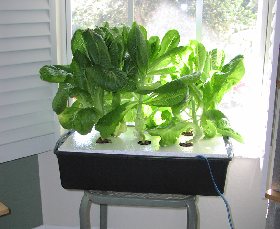
Technology provides us with the ability to advance what we do – do it faster, more reliably, on a bigger scale and more easily. Hydroponics is arguably the greatest technological advance that has come to home gardening. Compared to “traditional” soil gardening, hydroponics gardening has some significant advantages.
Advantages of Hydroponics
The major advantage that growing hydroponically provides is the ability to produce a larger crop in the same amount of space. This is because the need for soil is eliminated and it is the nutrient content of soil that is the limiting factor in determining how closely plants can grow to each other. By providing all the nutrients plants need within the water, nutrients can be provided at a higher concentration that what is found in soil, and continually replenished, eliminating the result of “tired soil” and the need for crop rotation.
The second major advantage of growing hydroponically over traditional soil gardening is that plants often grow faster and produce more leaves, fruit, flowers, or whatever their purpose is. This again is due to the nutrient availability that hydroponically-grown plants have over those grown in soil. By providing plants with the full amount of nutrients they need, they can continually grow at their full pace, and they have sufficient nutrients to produce more product.
By eliminating the need for soil, being able to grow hydroponically also eliminates all soil-borne diseases, fungi and parasites. In turn, this eliminates the need for pesticides to treat soil-borne diseases, providing for more healthy and more organically-grown produce.
Hydroponics gardens can also be grown inside with the use of grow lights to provide the light that these plants would otherwise not receive indoors. This means that plants can be grown hydroponically all year round, producing seasonal fruit for the entire year.
Getting Started with Hydroponics
For gardeners wanting to try out if they can use a hydroponic garden to grow what they have normally grown in soil, there are many kits and ready-built systems available that are easy to set up and maintain.
Plants that are particularly suited to being grown hydroponically are those with small root systems such as lettuce, herbs, strawberries, tomatoes and peppers. It is the root system that takes up space in a hydroponic setup and small roots mean more plants can be grown within a given area. The only types of plants that can’t easily be grown hydroponically are root vegetables. Although an interesting story is that astronauts have been able to grow radishes hydroponically in space.
For those starting out, it is suggested that a simple and easy to set up and maintain “water culture” hydroponics system be used as a first step. All that is required for this system is some hydroponic nutrient solution, some net pots, an air pump and an air stone, a box to contain everything within and some seedlings. Lettuce grows perfectly well in water culture hydroponics systems and in fact are grown using this method on a commercial scale.
Pavel Sluka is the owner of Hydroponics Habitat.
Related Articles & Free Email Newsletter
7 Things to Know Before You Go Hydro
Grow Systems and Supplies for Successful Home Hydroponics
Hydroponic Terminology – Let’s be sure we are Speaking the Same Language!



Comment here